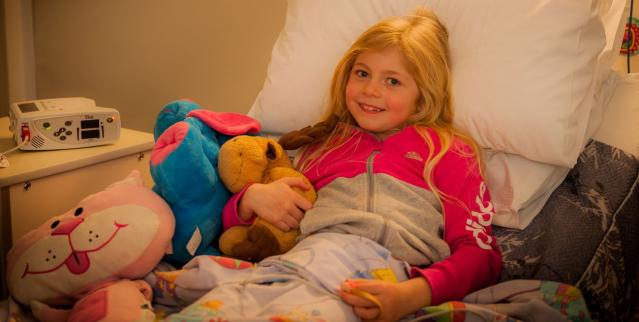Key points about overnight oximetry
- an oximetry test measures the amount of oxygen in the blood
- it's safe, simple and painless
- doctors can use an overnight oximetry test to assess your child's breathing during sleep (for example, due to narrowing or obstruction of the airway)
- even if your child's overnight oximetry is normal, they still may have problems breathing during sleep
- the health professional who arranged the overnight oximetry test is responsible for letting you know the results and arranging any follow-up treatment or tests

What is an oximetry?
An oximetry test uses a machine called a pulse oximeter. The test involves putting a sensor onto your child's finger, toe or ear lobe. The sensor uses light to measure the amount of oxygen in your child's blood, as well as their heart rate. It does not hurt and is very simple to put on and use.
Type of oximetry testing
Oximetry can measure the amount of oxygen in your child's blood in either of these ways:
- as a quick and easy test done in a few minutes (spot oximetry), or
- over a longer period of time, either at home or in hospital
Spot oximetry
Health professionals can use spot oximetry to check for low oxygen levels (hypoxia) in newborn babies to help identify those who may have been born with heart problems. It only takes a few minutes. The neonatal doctor (a doctor who looks after newborn babies) will give you more information.
Continuous pulse oximetry
Health professionals can use continuous pulse oximetry over a period of hours or days in hospital when a child is sick. It can help guide decisions about whether your child needs oxygen therapy. Sometimes, when a child needs to use respiratory equipment at night for their breathing, continuous oximetry can show whether the treatment is working properly.
Overnight pulse oximetry
Overnight pulse oximetry can happen in hospital or at home to measure oxygen levels when a child is asleep. It can be used in 2 ways.
To check for low oxygen levels (hypoxia)
Low oxygen levels may be due to poor or low lung function. For example, in a baby who was premature and may need oxygen.
To assess whether there are brief changes or drops or 'dips' in oxygen levels
Changes, or drops or 'dips' in oxygen levels may be related to possible disordered breathing during sleep.
Disordered breathing during sleep can be due to:
- narrowing or obstruction of the airway (called 'sleep disordered breathing')
- pauses in breathing (apnoea)
- shallow breathing (hypoventilation)
Snoring Or Noisy Breathing In Children
Arranging overnight oximetry for your child
Your health professional arranges an overnight oximetry test through your local hospital. Usually, a technologist or nurse will set up the oximeter in the hospital so that the settings and alarms are right for your child. They will give you instructions for using the machine, including how to place and fix the sensor for best results. You usually borrow the machine overnight and return it to the hospital the next day.
How overnight oximetry works
Before the oximetry test
Before the oximetry test, you can help prepare your child by explaining what is going to happen and reassuring them. If your child is having oximetry to find out if they have sleep disordered breathing, there may be a short sleep questionnaire to complete. It will really help your doctor to have a summary of your child's symptoms (for example, snoring, noisy breathing, pauses in breathing, daytime sleepiness and behaviour problems).
During the overnight oximetry
During the overnight oximetry, it can also be really helpful if you keep a note of:
- any important events that happen while the oximeter is recording
- what time they happened
Examples are:
- being awake
- crying
- being asleep
- feeding
- noisy breathing or snoring
- problems with equipment
- alarms
It's also a good idea to record whether you felt your child's sleep was typical of a normal night's sleep for them.
The doctors need to have as much of your child's overnight sleep recorded as possible on the oximeter, or at least 6 hours of recording.
Possible risks from an oximetry test
There is little risk involved. Very occasionally, a child's skin may react to the tapes or sensors resulting in a short-term rash. Oximetry itself is painless but may be distracting or annoying for some tamariki (children) because of the red light from the sensor. Staff will tell you how to hide the sensor, if on a foot, by putting a sock over the top.
Overnight oximetry test results
When you return the oximeter to the hospital, the doctor will analyse the data or information from the machine and send a report to the health professional who arranged the oximetry test. If the recording time is less than 6 hours, your child may need to do another oximetry test.
When oximetry testing is used to help find out if there is snoring or noisy breathing, it's important to remember that having a normal oxygen level does not mean that your child does not have sleep disordered breathing. It also doesn’t mean that they won't need further tests or treatments.
The health professional who arranged the overnight oximetry is responsible for letting you know the results of the study and working with you and your child if any further follow-up tests or treatments are necessary.
Acknowledgements
The content on this page has been developed and approved by the Paediatric Respiratory and Sleep Clinical Network, Paediatric Society New Zealand.
References
Paediatric Sleep Medicine Clinical Network. Paediatric Society New Zealand. 2015. Guidelines for the assessment of sleep-disordered breathing in children.
Starship Clinical Guidelines. 2021. Oximetry.
Australian Sleep Association. Overnight Oximetry for evaluating paediatric obstructive sleep apnoea.
